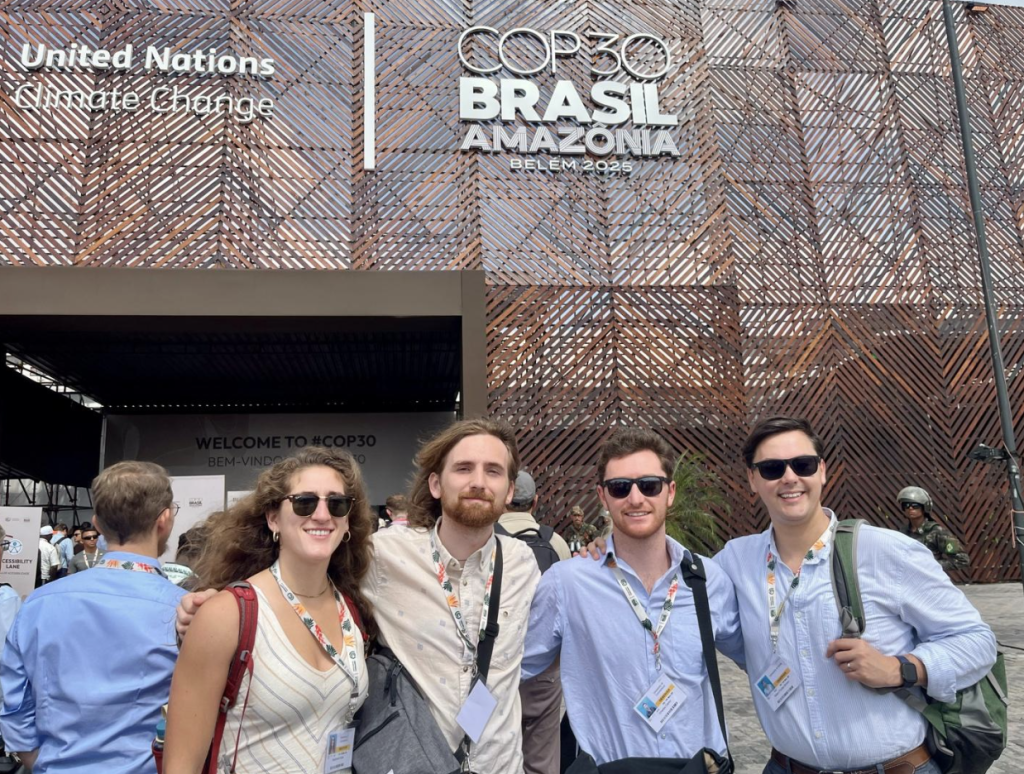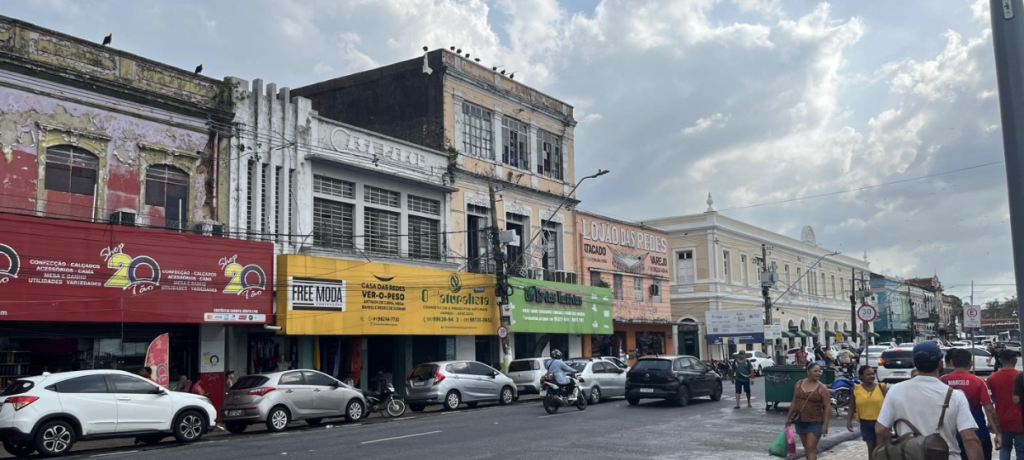COP30 Day 5: At the Gateway to the Amazon: Notes From COP30 in Belém
Adam Fortier-Brown
The views expressed herein belong exclusively to the delegate attending COP30 to observe and study international climate governance; they do not necessarily reflect those of the University or the Climate Change Institute.

The United Nation’s annual climate conference, COP30, is being hosted in Belém, Brazil: The “gateway to the Amazon.” Hosting COP here was a deliberate choice.
Hosting it here puts negotiators from almost 200 countries into a community on the front lines of the issues being negotiated, while also highlighting Brazil’s own priorities to show off its efforts to curb deforestation and reduce its emissions.
The symbolism is hard to ignore. Belém is a city in the shadow of one of the world’s most important ecosystems, that both feels the consequences of global warming and plays a critical role in regulating our planet’s climate.

Why Belém Matters
Belém is beautiful and complicated. It feels as if it could almost be absorbed by the rainforest. It has winding streets, vibrant local food and culture, beautiful architecture, and a sincerely kind population. At the same time, Belém is a city struggling with high poverty and significant challenges like inadequate infrastructure, less predictable rainfall, and increasing heat.
In the lead up to COP, hundreds of millions of dollars have been invested in the city to create its first sewer system and wastewater treatment plant, expand running water access to different communities, and to renovate canals and parks to prepare the city for the world’s attention.
The negotiations at COP about the costs of adaptation and the uneven impacts of climate change collide with the day-to-day economic challenges the people in this community face. It is no wonder then why the city has also faced multiple (mostly peaceful) protests from Indigenous communities and climate activists demanding more work be done to meet their needs.
In a sense, Belém feels like an appropriate setting for this year’s negotiations. The city embodies the possibility and contradictions about this kind of work—the need to act quickly to address the impacts of climate change, the difficulty of doing so in ways that meet people’s immediate needs, the hope that meaningful progress is still possible, and yes, the irony of flying in 60,000 people from around the world to talk about reducing emissions.
The polished speeches and declarations by negotiators and diplomats inside the pavilions sometimes sit uneasily against the backdrop of the energy of the city beyond the conference’s gates. But this contrast has made the whole experience, in its own way, feel a little more honest. It reminds everyone that the work being done isn’t some abstract policy problem to be solved through another white paper, or while meeting in a global center of commerce like Paris, or Madrid, or Dubai. The decisions made here will have a direct impact of the lives of millions of people around the world, and more intensely to those living in communities around the world like Belém.

From Paris to Belém
Nearly a decade since the Paris Climate Agreement, countries have set ambitious goals to transition away from fossil fuels, fight deforestation, and adapt to the impacts of climate change. This year at Belém, it’s all about implementation: How do we actually do this? Who pays for it? How can we get countries and communities in agreement enough to make real progress?
These questions must be answered in one of the most complex geopolitical moments in decades—marked by increasing regional conflicts, financial strain, growing instability, and, notably, the absence of a formal United States delegation.
This week, I focused my research on adaptation. Specifically, what nations can do to become more resilient to the impacts of climate change, and what sort of indicators nations will use to track their progress towards their goals. I sat in on several negotiations for one of the most talked about the Global Goal on Adaptation (GGA).
Global Goal on Adaptation
The Global Goal on Adaptation is a collective commitment under Article 7.1 of the Paris Climate Agreement to improve countries’ capacity to adapt to, become more resilient to, and less vulnerable to the impacts of climate change. After eight years with no meaningful progress, negotiators reached an agreement on an overarching framework at COP28.
Coming into COP 30, negotiators are meant to review metrics (called “indicators”) that were selected by a team of leading scientific experts, ranging from issues on water, food, public health and the health of ecosystems, national infrastructure, and poverty. The process began with thousands of indicators and was reduced down to 100 to be more manageable for reporting nations.
This week, negotiators were tasked with finalizing these indicators so that nations have a better idea about where climate adaptation investments are working, and where they aren’t. Once adopted, these indicators will help nations implement approaches that can be adapted to the regional and specific needs of their nation. Additionally, these indicators will provide a way for nations to measure progress towards adaptation efforts and make a case for more targeted financial and technical support to meet their goals.
The negotiations I sat in for were tense, and the disagreements showed up almost immediately. The geopolitical relationships were familiar, with Western nations huddling together in one corner of the room to coordinate an approach, while developing nations and China coordinate their own approach across the room.
Some nations argued that the group should review each indicator to determine which should be adopted, and which should not—an approach that often felt like a way to slow down the whole process, or water down the indicators these nations felt were inconvenient to their own national interests. Other nations pushed to adopt the proposed indicators in full and move onto the important work of determining how to measure and report them.
As the week wrapped up, it seemed like there was no clear path forward on the GGA.
Bringing it Home
One thing that resonated with me at the COP was how similar the challenges are across the world. Part of the value of attending something like COP30 is that, even as a non-negotiating party, it brings together community leaders, researchers, business leaders, and NGOs from across the world to get together and figure out what approaches are working well, and how to implement those approaches to make their respective communities stronger.
By attending different sessions, I was able to learn how different regions of the world are adapting in ways that could be translated back home and see how we can potentially make our own state more resilient to the impacts of climate change.
It also feels like the whole conversation around climate change has shifted. We seem to be past the era of big, aspirational climate pledges, and now seem to be in a more challenging era of figuring out how to adapt and become more resilient to climate risks today.
This creates difficult conversations about the best ways to respond to the impacts of climate change, who is responsible for paying for it, and how the world can come together in some way to make sure that the poorest in the world are not shouldering the most severe impacts of climate change.
Still, there is a lot of optimism in this work.
Despite missing our goal to limit warming to 1.5°C above preindustrial temperatures, the momentum from the private sector and local governments were visible. Businesses are pushing sustainability because clean energy is often cheaper and more resilient in many cases. There is still a significant interest in creating technologies like improved battery storage systems to ensure that clean energy becomes more reliable in the future. Local communities, counties, and regional governments are finding creative ways to adapt to climate change and continuing to create more incentives to make their communities more sustainable and resilient to climate risks.
Besides negotiations, we also made time for some fun. Between swimming in the Amazon River, going on a hike into the jungle, visiting local shops, trying new foods, and turning another year older at a locals-only spot, this has been a truly unforgettable week. I am grateful that the University of Maine prioritizes giving students opportunities to connect with brilliant people from across the world and see these negotiations in person. I am looking forward to following how negotiations progress this next week and bringing some of what I learned to my work back home in Maine.
This is the part of a series of daily blog posts from the University of Maine delegation to COP30.

